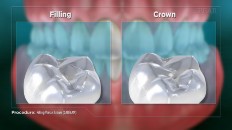 When a tooth has been compromised by decay, your doctor may choose to use a filling or a crown to repair it. There are some differences to consider when evaluating your options.
When a tooth has been compromised by decay, your doctor may choose to use a filling or a crown to repair it. There are some differences to consider when evaluating your options.
 When repairing a small area of decay, a filling is a great option. A filling can be completed in a single appointment and is less expensive than a crown.
When repairing a small area of decay, a filling is a great option. A filling can be completed in a single appointment and is less expensive than a crown.
 The cavity can be filled with a material called composite, which mimics the tooth's natural shade and sheen. Once completed, the filling should stop the decay and keep the tooth healthy for a number of years.
The cavity can be filled with a material called composite, which mimics the tooth's natural shade and sheen. Once completed, the filling should stop the decay and keep the tooth healthy for a number of years.
 Drawbacks of a filling can be a shorter comparative lifespan, and potential long term issues like recurring decay and cracking.
Drawbacks of a filling can be a shorter comparative lifespan, and potential long term issues like recurring decay and cracking.
 Placing a crown is best when a tooth has been weakened by extensive decay, injury, or deterioration of a large filling. A crown procedure involves reducing the surface area of the whole tooth to remove the decay, and then covering it entirely with a restoration made of ceramic or composite.
Placing a crown is best when a tooth has been weakened by extensive decay, injury, or deterioration of a large filling. A crown procedure involves reducing the surface area of the whole tooth to remove the decay, and then covering it entirely with a restoration made of ceramic or composite.
 Crowns are more durable and last longer than a filling, and protect teeth from fracturing over time. While requiring a more involved procedure, a crown can also be completed in a single appointment when using digital scanning and onsite fabrication.
Crowns are more durable and last longer than a filling, and protect teeth from fracturing over time. While requiring a more involved procedure, a crown can also be completed in a single appointment when using digital scanning and onsite fabrication.
 In the right circumstances, both a filling and a crown are excellent solutions for repairing decayed or damaged teeth. It is important that you consult with your doctor so that the right choice can be made based upon your unique needs.
In the right circumstances, both a filling and a crown are excellent solutions for repairing decayed or damaged teeth. It is important that you consult with your doctor so that the right choice can be made based upon your unique needs.
Copyright © 2016 Spear Education. All rights reserved.